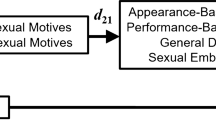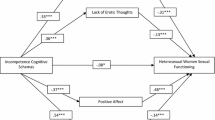Abstract
The present study examined 100 lesbian and gay college students and 100 heterosexual students to determine whether group differences exist in frequency of a range of non-erotic cognitive distractions during sexual activity. Non-erotic cognitive distraction is a descriptive term for both self-evaluative cognitions related to physical performance and body image concerns, as well as additional cognitive distractions (e.g., contracting an STI or emotional concerns) during sexual activity. Participants were matched on gender (96 males and 104 females), age, and ethnicity, and completed questionnaires assessing frequency of non-erotic cognitive distractions during sexual activity, as well as measures of additional variables (trait and body image anxiety, attitudes toward sexual minorities, self-esteem, and religiosity). Results indicated that sexual minorities experienced significantly more cognitive distractions related to body image, physical performance, and STIs during sexual activity than heterosexuals. Regarding gender, men reported more distractions related to STIs than women. Interaction effects were observed between sexual orientation and gender for body image-, disease-, and external/emotional-based distractions. Implications of these findings are discussed.
Similar content being viewed by others
References
Abrahamson, D. J., Barlow, D. H., Beck, J. G., Sakheim, D. K., & Kelly, J. P. (1985). The effects of attentional focus and partner responsiveness on sexual responding: Replication and extension. Archives of Sexual Behavior, 14, 361–371.
Althof, S. E., O’Leary, M. P., Cappelleri, J. C., Glina, S., King, R., Tseng, L., et al. (2006). Self-esteem, confidence, and relationships in men treated with sildenafil citrate for erectile dysfunction. Journal of General Internal Medicine, 21, 1069–1074.
Bancroft, J., Carnes, L., Janssen, E., Goodrich, D., & Long, J. S. (2005). Erectile and ejaculatory problems in gay and heterosexual men. Archives of Sexual Behavior, 34, 285–297.
Batson, C. D., Schoenrade, P., & Ventis, W. L. (1993). Religion and the individual: A socio-psychological perspective. New York: Oxford University Press.
Beaber, T. E., & Werner, P. D. (2009). The relationship between anxiety and sexual functioning in lesbians and heterosexual women. Journal of Homosexuality, 56, 639–654.
Beck, J. G., & Barlow, D. H. (1986). The effects of anxiety and attentional focus on sexual responding: I. Physiological patterns in erectile dysfunction. Behaviour Research and Therapy, 24, 9–17.
Center for Disease Control and Prevention. (2010). HIV among gay, bisexual and other men who have sex with men (MSM). Retrieved from http://www.cdc.gov/hiv/topics/msm/index.htm.
Centers for Disease Control and Prevention. (2007). HIV/AIDS and men who have sex with men (MSM). Retrieved from http://www.cdc.gov/hiv/topics/msm/.
Conner, M., Johnson, C., & Grogan, S. (2004). Gender, sexuality, body image, and eating behaviours. Journal of Health Psychology, 9, 505–515.
Crawford, M., & Popp, D. (2003). Sexual double standards: A review and methodological critique of two decades of research. Journal of Sex Research, 40, 13–26.
Dove, N. L., & Wiederman, M. W. (2000). Cognitive distraction and women’s sexual functioning. Journal of Sex and Marital Therapy, 26, 67–78.
Frederick, D. A., Forbes, G. B., Grigorian, K. E., & Jarcho, J. M. (2007). The UCLA Body Project I: Gender and ethnic differences in self-objectification and body satisfaction among 2,206 undergraduates. Sex Roles, 57, 317–327.
Geer, J. H., & Fuhr, R. (1976). Cognitive factors in sexual arousal: The role of distraction. Journal of Consulting and Clinical Psychology, 44, 238–243.
Greaves, R. M. (2001). The social construction of sexual interaction in heterosexual relationships: A qualitative analysis. Dissertation Abstracts International: Section A: Humanities and Social Sciencs, 61(11-A), 4565.
Greene, K., & Faulkner, S. (2005). Gender, belief in the sexual double standard, and sexual talk in heterosexual dating relationships. Sex Roles, 53, 239–251.
Iwasaki, Y., & Ristock, J. L. (2007). The nature of stress experienced by lesbians and gay men. Anxiety, Stress & Coping, 2, 299–319.
Kerns, J. G., & Fine, M. A. (2005). The relation between gender and negative attitudes toward gay men and lesbians: Do gender role attitudes mediate this relation? Sex Roles, 31, 297–307.
Kinsey, A. C., Pomeroy, W. B., & Martin, C. E. (1948). Sexual behavior in the human male. Philadelphia: W. B. Saunders.
Larsen, K. S., Reed, M., & Hoffman, S. (1980). Attitudes of heterosexuals toward homosexuality: A Likert-type scale and construct validity. Journal of Sex Research, 16, 245–257.
Masters, W. H., & Johnson, V. E. (1970). Human sexual inadequacy. Boston: Little, Brown and Company.
Meana, M., & Nunnink, S. E. (2006). Gender differences in the content of cognitive distraction during sex. Journal of Sex Research, 43, 59–67.
Meston, C. M. (2005). The effects of state and trait self-focused attention on sexual arousal in sexually functional and dysfunctional women. Behaviour Research and Therapy, 44, 1–19.
Morrison, M., Morrison, T., & Sager, C. (2004). Does body satisfaction differ between gay men and lesbian women and heterosexual men and women? A meta-analytic review. Body Image, 1, 127–138.
Murray, K. M., Ciarrocchi, J. W., & Murray-Swank, N. A. (2007). Spirituality, religiosity, shame and guilt as predictors of sexual attitudes and experiences. Journal of Psychology and Theology, 35, 222–234.
Nelson, A. L., & Purdon, C. (2010). Non-erotic thoughts, attentional focus, and sexual problems in a community sample. Archives of Sexual Behavior, 40, 395–406.
Peplau, L. A., Frederick, D. A., Yee, C., Maisel, N., Lever, J., & Ghavami, N. (2009). Body image satisfaction in heterosexual, gay, and lesbian adults. Archives of Sexual Behavior, 38, 713–725.
Purdon, C., & Holdaway, L. (2006). Non-erotic thoughts: Content and relation to sexual functioning and sexual satisfaction. Journal of Sex Research, 43, 154–162.
Purdon, C., & Watson, C. (2011). Non-erotic thoughts and sexual functioning. Archives of Sexual Behavior. doi:10.1007/s10508-011-9755-z.
Reed, D. L., Thompson, J. K., Brannick, M. T., & Saco, W. P. (1991). Development and validation of the Physical Appearance State and Trait Anxiety Scale (PASTAS). Journal of Anxiety Disorders, 5, 323–332.
Rosenberg, M. (1989). Society and the adolescent self-image (revised ed.). Middletown, CT: Wesleyan University Press.
Rowen, C. J., & Malcolm, J. P. (2002). Correlates of internalized homophobia and homosexual identity formation in a sample of gay men. Journal of Homosexuality, 43, 77–92.
Sakheim, D. K., Barlow, D. H., & Beck, J. G. (1984). The effect of an increased awareness of erectile cues on sexual arousal. Behaviour Research and Therapy, 22, 151–158.
Siever, M. D. (1994). Sexual orientation and gender as factors in socioculturally acquired vulnerability to body dissatisfaction and eating disorders. Journal of Consulting and Clinical Psychology, 62, 252–260.
Smolenski, D. J., Ross, M. W., Risser, J. M. H., & Rosser, B. R. S. (2009). Sexual compulsivity and high-risk sex among Latino men: The role of internalized homonegativity and gay organizations. AIDS Care, 21, 42–49.
Spielberger, C. D., Gorsuch, R. L., Lushene, R., Vagg, P. R., & Jacobs, G. A. (1983). Manual of the State-Trait Anxiety Inventory. Palo Alto, CA: Consulting Psychologists Press.
Tabachnick, B. G., & Fidell, L. S. (2001). Using multivariate statistics. Boston: Pearson/Allyn & Bacon.
Trapnell, P. D., Meston, C. M., & Gorzalka, B. B. (1997). Spectatoring and the relationship between body image and sexual experience: Self-focus or self-valence? Journal of Sex Research, 34, 267–278.
Ward, J., & Winstanley, D. (2005). Coming out at work: Performativity and the recognition and renegotiation of identity. Sociological Review, 53, 447–475.
Author information
Authors and Affiliations
Corresponding author
Appendix
Appendix
Non-Erotic Cognitive Distractions Questionnaire
People often have thoughts during their sexual encounters that detract from the quality of the experience. Please respond to the following items in reference to the last few times you have engaged in sexual activity.
-
1.
During sexual activity, I worry about how my body looks.
1
2
3
4
5
Never
Rarely
Sometimes
Often
Always
-
2.
It is difficult to enjoy sex because of my concerns over how my body appears to my partner.
-
3.
During sexual activity, I think about how unattractive my body is.
-
4.
During sexual activity, I worry that my partner will get turned off by seeing my body without clothes.
-
5.
During sexual activity, I prefer to be in a position such that my partner cannot see my body.
-
6.
During sexual activity, I worry that my partner may not enjoy the activity with me.
-
7.
During sexual activity, I worry that my partner will not have an orgasm.
-
8.
I worry about whether my actions are satisfying my partner during sexual activity.
-
9.
During sexual activity, I am distracted by thoughts about my sexual performance.
-
10.
During sexual activity, I have concerns that someone may see or catch me in the act.
-
11.
I worry about getting a sexually transmitted disease (STD) during sexual activity.
-
12.
I worry about getting AIDS during sexual activity.
-
13.
During sexual activity, I worry that someone may overhear what I am doing.
-
14.
During sexual activity, I feel guilty about having sex.
-
15.
During sexual activity, I feel like I am doing something immoral or sinful.
Rights and permissions
About this article
Cite this article
Lacefield, K., Negy, C. Non-Erotic Cognitive Distractions During Sexual Activity in Sexual Minority and Heterosexual Young Adults. Arch Sex Behav 41, 391–400 (2012). https://doi.org/10.1007/s10508-011-9792-7
Received:
Revised:
Accepted:
Published:
Issue Date:
DOI: https://doi.org/10.1007/s10508-011-9792-7




